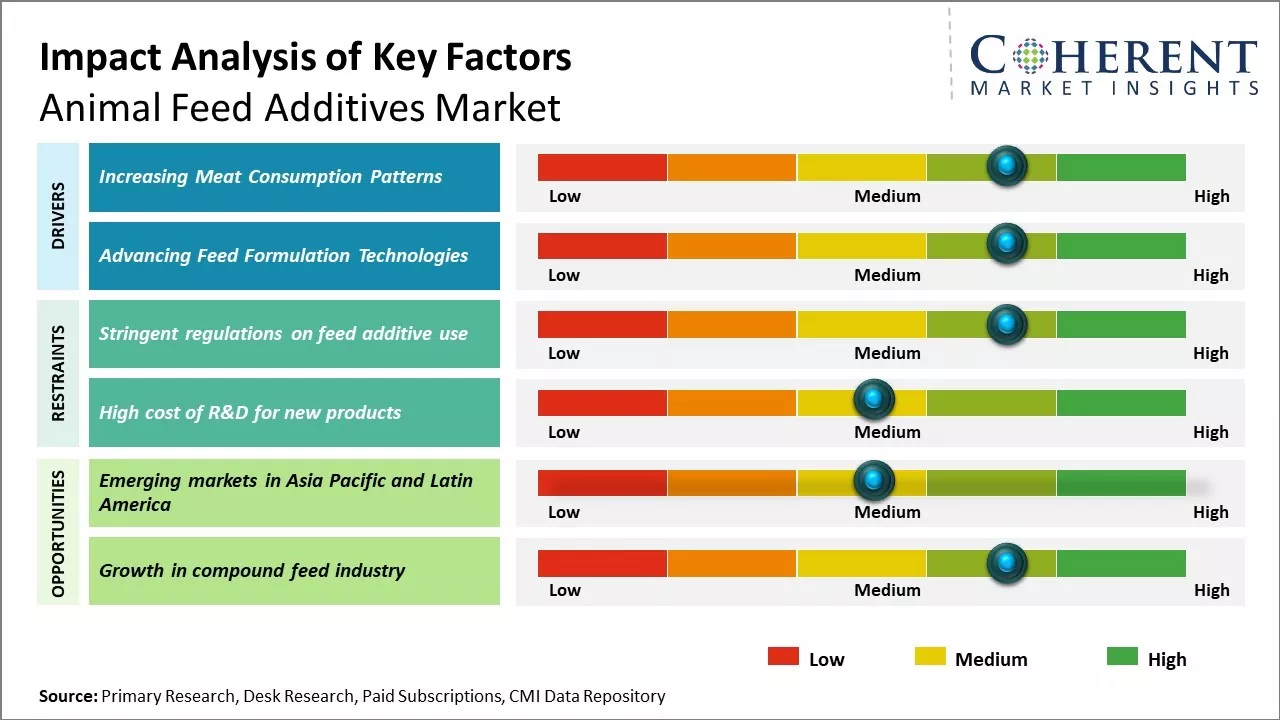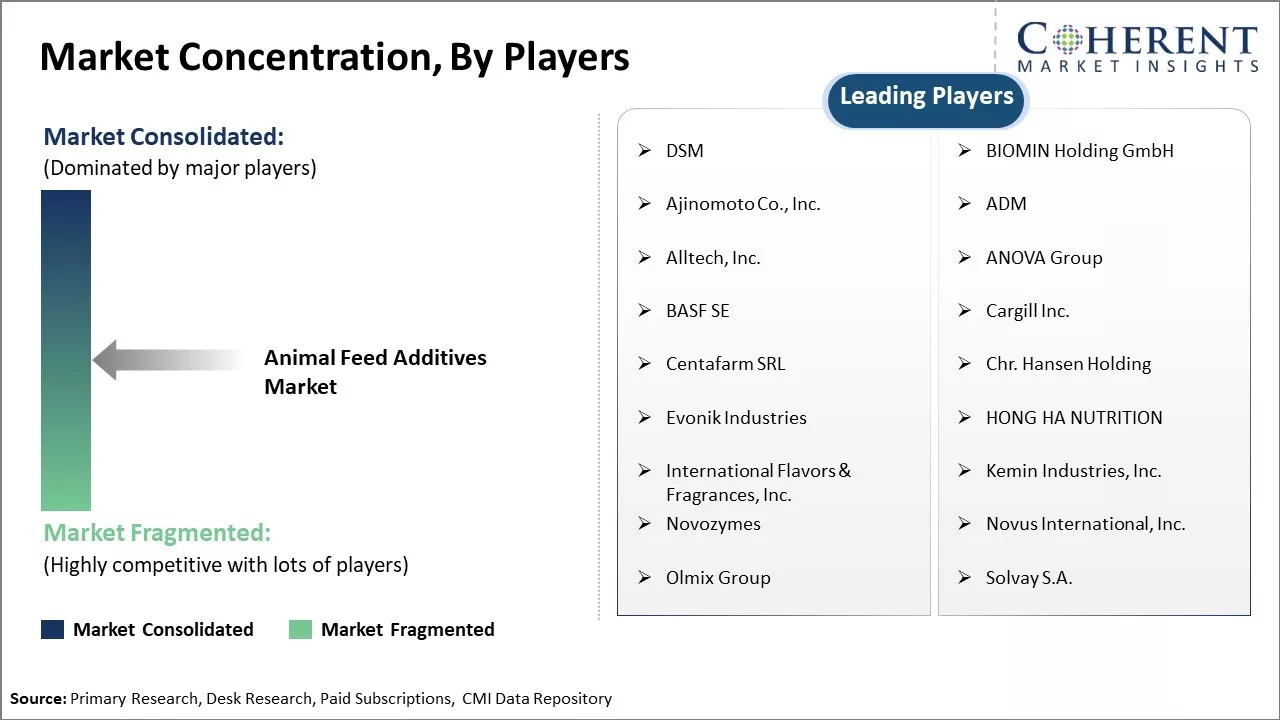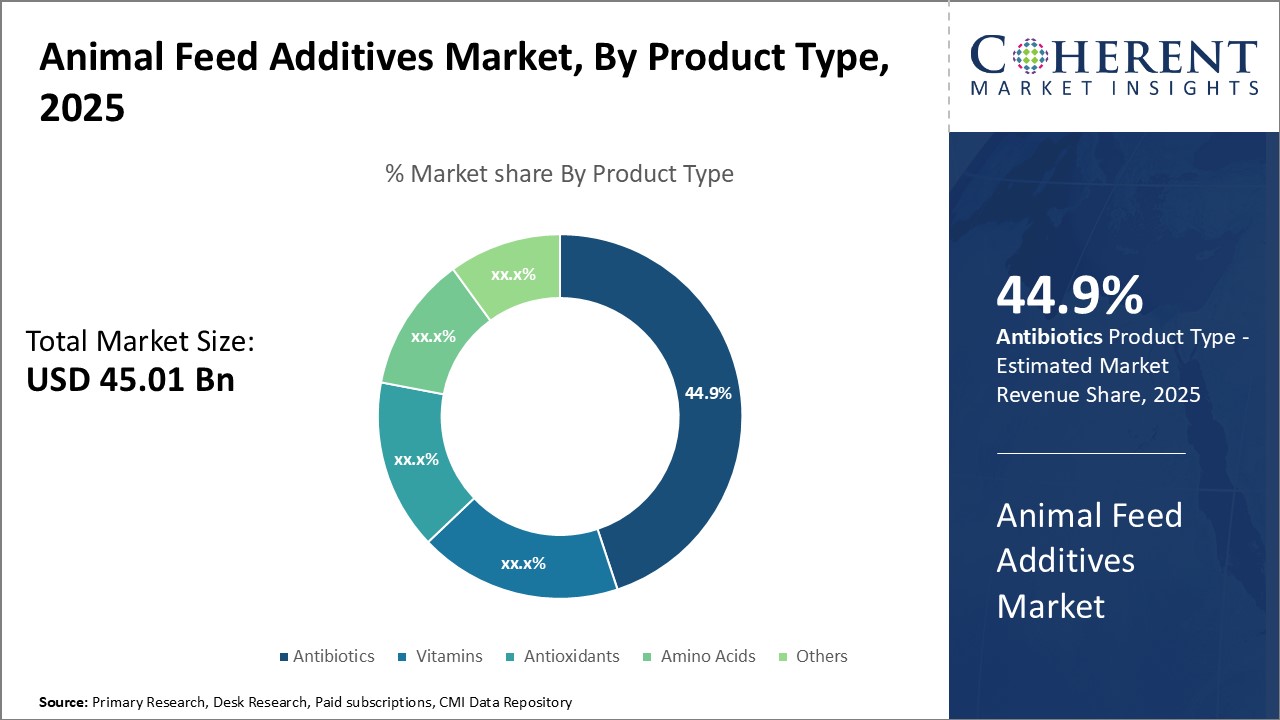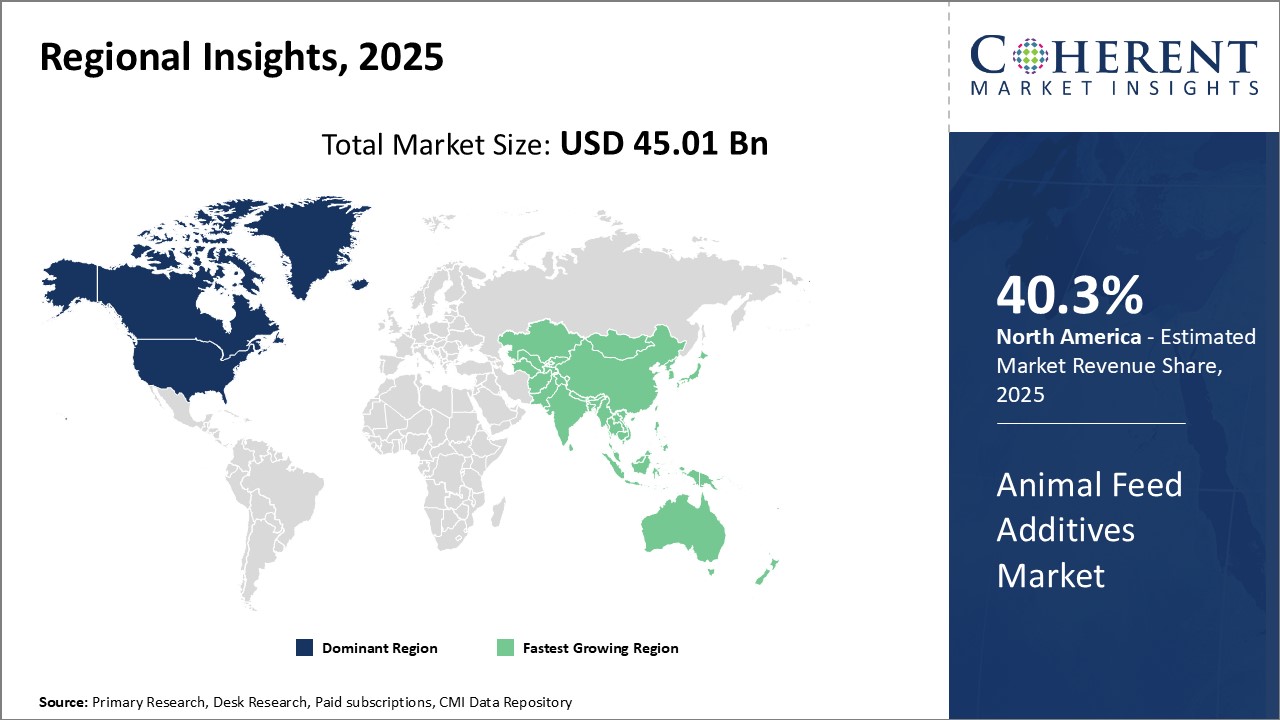The animal feed additives market is estimated to be valued at USD 45.01 Bn in 2025 and is expected to reach US$ 57.69 Bn by 2032, exhibiting a compound annual growth rate (CAGR) of 3.6% from 2025 to 2032.

Discover market dynamics shaping the industry: Request sample copy
The increased demand for animal protein and rise in awareness about animal health are major factors driving the growth of this market. The market is witnessing increasing demand for natural feed additives from livestock producers as they are considered safer alternatives to antibiotics and growth promoters. Consumers are also more inclined towards animal products like meat and milk from livestock fed natural feed additives. There is growing popularity of probiotics, prebiotics, enzymes, and acidifiers as natural feed additives. Manufacturers are investing in the development of innovative and customized formulations of natural feed additives targeted for specific livestock such as poultry, ruminants, swine, and aquaculture. This is expected to propel the animal feed additives market expansion during the forecast period.
Increasing Meat Consumption Patterns
One of the major drivers that is expected to significantly fuel the growth of the global animal feed additives market in the coming years is the steadily increasing meat consumption worldwide. This is mainly being driven by rising incomes, growing populations, and urbanization in developing regions. As people's standard of living improves, their dietary preferences tend to shift towards more resource-intensive animal products such as poultry, pork, and beef. This boosts the demand for livestock and leads to the increased production of meat and related products. Boosting livestock growth, health and productivity remain top priorities for farmers and feed producers to meet surging meat demand. This is where animal feed additives play a pivotal role by enhancing the nutritional value of animal feed and optimizing feed conversion rates. From probiotics and prebiotics to acidifiers, antioxidants and enzymes, various additive solutions are increasingly being incorporated in animal feed to support healthier growth and development of livestock animals. Going forward, the surge in global meat consumption especially in emerging nations is likely to induce higher spending on affordable feed additives, thus accelerating the overall growth trajectory of this market in the years to come.

Get actionable strategies to beat competition: Request sample copy
Advancing Feed Formulation Technologies
Another major factor driving innovations and advancements in the animal feed additives market relates to ongoing developments in feed formulation techniques. There is growing research in the area of feed formulation management to reduce overall feed costs and maximize output benefits for farmers and producers. Use of scientific formulations along with specialized feed additive mixes help address specific animal nutrition needs while maintaining cost efficiency. Furthermore, stricter regulatory norms regarding antibiotic growth promoters have galvanized extensive R&D efforts from leading additive manufacturers towards developing novel, viable alternatives such as prebiotics, probiotics, phytogenics, and organic acids. Advanced technologies such as precision livestock farming techniques also provide real-time data on herd health and productivity. This allows for customized nutrient optimizations and dynamic formulation changes using functional feed additives. Such technological interventions are helping address productivity challenges in livestock farming in a sustainable manner. Overall, continual improvements in feed formulations aimed at performance enhancement combined with increasing expenditure on R&D of innovative feed additive solutions augur well for market expansion.
Key Takeaways from Analyst:
Rising demand for animal proteins such as meat and dairy is a prime driver as it is prompting farmers and feed producers to maximize productivity and efficiency. The search for alternatives to antibiotic growth promoters will also support the market growth. Asia Pacific stands to gain the most owing to growing meat consumption in China and India as incomes rise in these populous nations.
The phytogenic segment is expected to see lucrative gains thanks to growing preference for natural and plant-derived additives over chemicals. Organic trace minerals also present opportunities for manufacturers as concerns over antibiotics spur demand for natural alternatives. Amino acids continue to dominate due to their widespread inclusion in commercial animal nutrition and feed formulation. The poultry industry outperforms other livestock sectors due to intensifying production to meet demand for chicken and eggs.
Regulations around antibiotic use will compel the industry to invest more in R&D to identify viable substitutes. Those able to offer natural, eco-friendly additives with proven benefits stand to attract customers among feed producers and farmers.
Market Challenges: Stringent regulations on feed additive use
Stringent regulations on feed additive use are posing a significant challenge for the growth of the global animal feed additives market. Many countries and regions have implemented strict rules around the types of additives that can be used in animal feed as well as maximum limits on certain additives like antibiotics and growth promoters. This is negatively impacting the adoption of high-performance feed additives among farmers and livestock producers.
Market Opportunities: Emerging markets in Asia Pacific and Latin America
The animal feed additives market in emerging economies of Asia Pacific and Latin America regions provides considerable growth prospects. These regions are witnessing rapid urbanization and income growth. As people's livestock-raising and meat consumption patterns change with increasing incomes, the demand for quality animal feed and focus on livestock health is surging. Several countries have also been investing heavily in boosting their agricultural production and productivity.

Discover high revenue pocket segments and roadmap to it: Request sample copy
Insights by Product Type: Growing demand for disease prevention
In terms of product type, antibiotics is expected to contribute the highest share of the market with 44.9% share in 2025. Antibiotics have long been an essential part of animal feed additives due to their ability to prevent disease outbreaks in livestock. By maintaining the health of farm animals, antibiotics help ensure optimal growth and feed efficiency. As animal agriculture has intensified globally to meet rising demand for meat and dairy, disease pressure on farm operations has increased considerably. Close quarters and high-density housing typical of large-scale livestock production facilitate the rapid spread of illness between animals. Left unchecked, infections can devastate herds and flocks, resulting in serious economic losses for farmers.
To shield farm animals from potentially devastating diseases, antibiotics are widely included in compound feed and water supplies. Their regular inclusion in diets helps to deter common bacterial pathogens while also supporting recovery from minor illnesses. Some of the most frequently used antibiotic classes in animal feed include penicillins, tetracyclines, macrolides, and sulfonamides. Continuous low-level exposure through feed is thought to be more protective than intermittent high doses administered therapeutically during outbreaks. As a result, antibiotics remain the backbone of disease prevention strategies on many commercial livestock and poultry operations around the world.
In addition, public health experts have warned about the emergence and spread of zoonotic diseases from animals to humans. By maintaining healthy livestock populations through judicious antibiotic use, disease transmission at the human-animal interface may be reduced. This protects global food security while limiting the size of disease reservoirs that could pose pandemic risks. For all these reasons, antibiotics will likely continue dominating the animal feed additive sector for the foreseeable future due to their irreplaceable role in safeguarding animal welfare and public health.
Insights by Livestock: Poultry production drives the demand for feed additives in the livestock segment
The poultry sector is expected to account for 43.8% share of the animal feed additives market among livestock types in 2025. Several factors underlying global poultry production trends fuel the demand for various additives. Chicken are vastly the most numerous domestically raised livestock species, with over 50 billion broiler meat chickens and egg-laying hens in production annually worldwide. Poultry meat has also emerged as one of the most affordable animal protein sources for both developed and developing populations.
Driven by economic growth, urbanization and changing diets, the global meat consumption is projected to rise substantially in the coming decades. Poultry will be pivotal in satisfying this demand trajectory given chickens' reputation as a relatively efficient converter of feed into meat. Additives are crucial for maximizing the nutritional value of poultry feed to support the rapid growth rates desired by producers. Additionally, high-intensity poultry systems concentrate many birds together, requiring greater reliance on additives to maintain health in these conditions.
In terms of livestock production systems, poultry is the easiest to industrialize and highly scalable. Integration into large concentrated animal feeding operations has been the dominant model to capitalize on economies of scale. These intensive rearing methods necessitate optimal nutrition, digestive performance and disease prevention - hallmarks enabled by productive use of various feed additives. Overall, structural factors cemented poultry as the primary subset driving additive innovation and uptake in the lucrative livestock feed segment.

Need a Different Region or Segment? Customize now
North America has established itself as the leading regional market for animal feed additives. The region is expected to account for 40.3% share of the market in 2025. The U.S. and Canada account for the bulk of demand owing to a strong presence of large-scale commercial livestock farming. Major feed additive producers have their headquarters located in the region allowing for efficient domestic supply and consolidation of global operations. Customers benefit from good access to new products and formulation expertise from these industry-leading companies. Well-established import/export infrastructure facilitates cross-border trade complementing the local production capabilities. Furthermore, the regional market enjoys regulatory consistency across jurisdictions helping stakeholders comply with various requirements smoothly.
The Asia Pacific region is witnessing the fastest growth in the animal feed additives market territory. Rapid economic development and urbanization have increased meat consumption in countries such as China, India and Indonesia. Local producers are expanding their operations aggressively to fulfil the growing protein demand from a burgeoning middle class. This, coupled with the desire to ensure nutritional adequacy and health of livestock, is driving additive adoption. Manufacturers from other parts of the world are entering strategic partnerships with regional players and setting up local manufacturing plants to capitalize on the opportunities. Local governments also recognize the importance of this industry in achieving self-sufficiency in agriculture and food production. They offer production-linked incentives to boost domestic supply further. Transportation costs give regional suppliers a competitive advantage over imports as well. Rising prosperity will continue augmenting demand for affordable animal proteins in Asia Pacific, thereby acting as a macro driver for feed additive usage.
Animal Feed Additives Market Report Coverage
| Report Coverage | Details | ||
|---|---|---|---|
| Base Year: | 2024 | Market Size in 2025: | USD 45.01 Bn |
| Historical Data for: | 2020 To 2024 | Forecast Period: | 2025 To 2032 |
| Forecast Period 2025 to 2032 CAGR: | 3.6% | 2032 Value Projection: | USD 57.69 Bn |
| Geographies covered: |
|
||
| Segments covered: |
|
||
| Companies covered: |
DSM, BIOMIN Holding GmbH, Ajinomoto Co., Inc., ADM, Alltech, Inc., ANOVA Group, BASF SE, Cargill Inc., Centafarm SRL, Chr. Hansen Holding, Evonik Industries, HONG HA NUTRITION, International Flavors & Fragrances, Inc., Kemin Industries, Inc., Novozymes, Novus International, Inc., Olmix Group, and Solvay S.A. |
||
| Growth Drivers: |
|
||
| Restraints & Challenges: |
|
||
Uncover macros and micros vetted on 75+ parameters: Get instant access to report
*Definition: The animal feed additives market consists of various components and supplements that are added to animal feed to improve the quality of the feed as well as support overall health, growth and development of livestock. Common animal feed additives include vitamins, amino acids, fatty acids, minerals, enzymes, and other nutritional supplements used primarily in poultry, cattle, swine and aquatic animal feed to enhance digestibility, improve feed conversion, promote growth and prevent diseases. The global animal feed additives market is seeing steady gains as demand for meat and dairy products rises around the world.
Share
Share
About Author
Pankaj Poddar is a seasoned market research consultant with over 12 years of extensive experience in the fast-moving consumer goods (FMCG) and plastics material industries. He holds a Master’s degree in Business Administration with specialization in Marketing from Nirma University, one of India’s reputed institutions, which has equipped him with a solid foundation in strategic marketing and consumer behavior.
As a Senior Consultant at CMI for the past three years, he has been instrumental in harnessing his comprehensive understanding of market dynamics to provide our clients with actionable insights and strategic guidance. Throughout his career, He has developed a robust expertise in several key areas, including market estimation, competitive analysis, and the identification of emerging industry trends. His approach is grounded in a commitment to understanding client needs thoroughly and fostering collaborative relationships. His dedication to excellence and innovation solidifies his role as a trusted advisor in the ever-evolving landscape of not only FMCG but also chemicals and materials markets.
Missing comfort of reading report in your local language? Find your preferred language :
Transform your Strategy with Exclusive Trending Reports :
Frequently Asked Questions
Joining thousands of companies around the world committed to making the Excellent Business Solutions.
View All Our Clients
US Reciprocal Tax Impact Analysis On Animal Feed Additives Market
Stay updated on tariff changes with expert insights and timely information